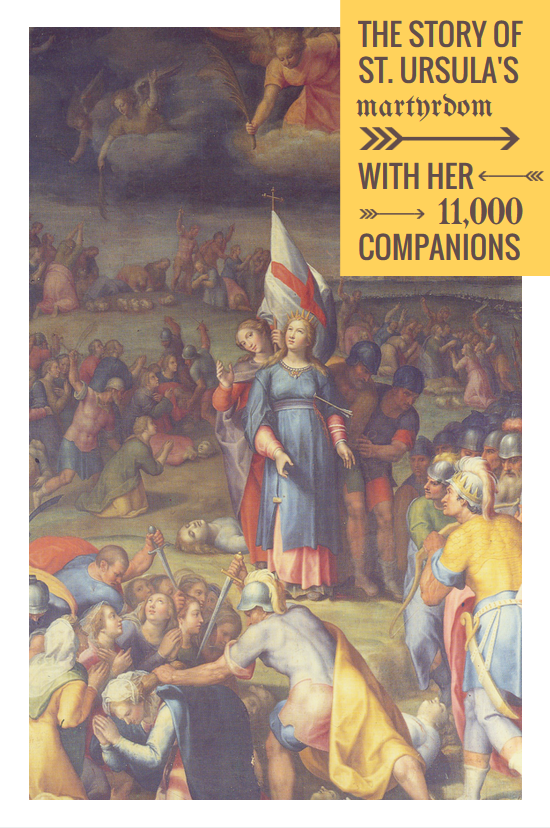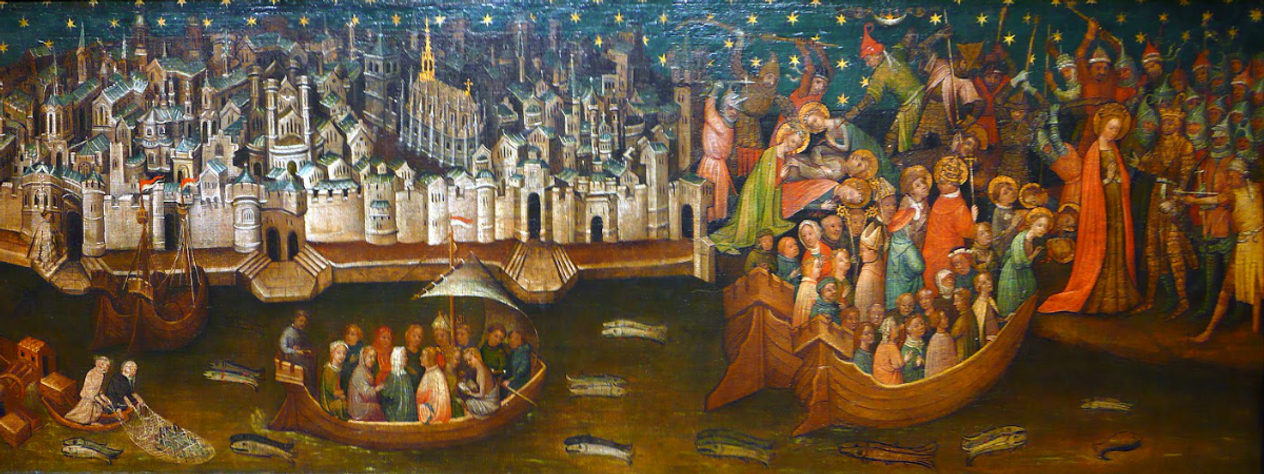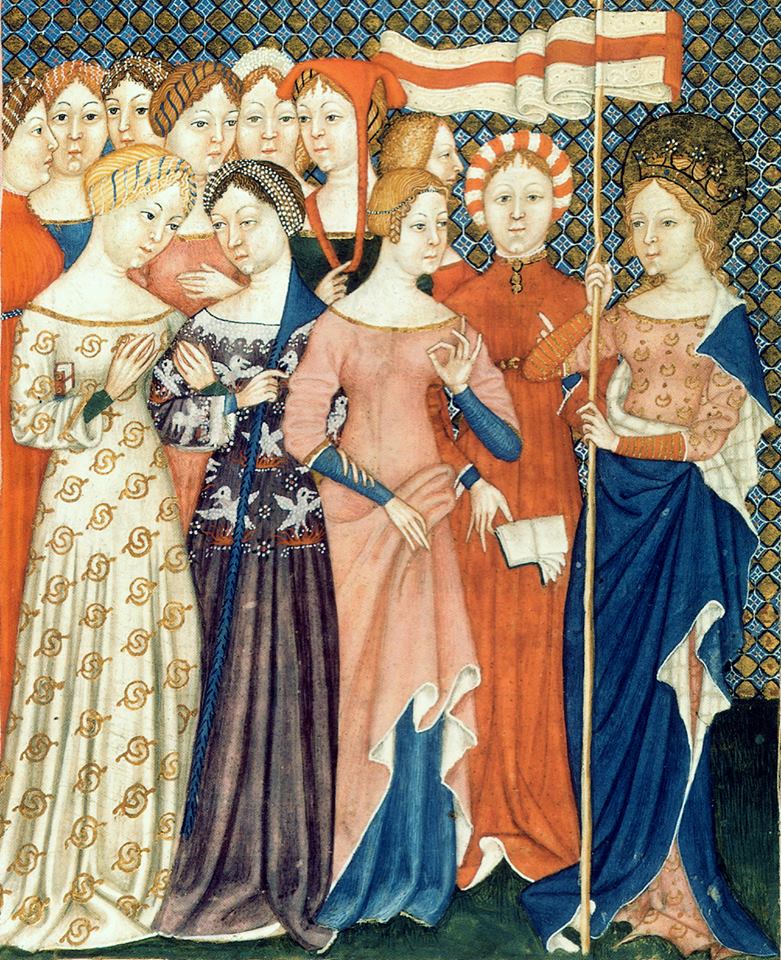The Story of St. Ursula the Warrior Princess and her 11,000 Companions
Oct 20, 2016 by Gretchen Filz
October 21st is the feast day of St. Ursula, a holy woman and venerated martyr shrouded in mystery. According to legend she was a 4th century princess from Britain who was martyred by the Huns in Cologne, Germany. Included in her feast day are 11,000 companions who were massacred along with her, many of them virgin handmaids of her royal entourage.
However, St. Ursula is not mentioned in the old hagiographies of credible Church historians. Due to the late and varying accounts we do have of her martyrdom from less-than-reliable sources, and the difficulty of separating fact from legend, she was removed from Roman liturgical calendar in modern times.
Those incredulous about such an enormous number of people killed, with such uncertain historical record to vouch for its truth, reasoned that the number of her companions must have been a medieval "typo"; perhaps there were a few too many zeros mistakenly added to the end of that number. It was probably more like 1,000, or 100, or even 11 women who were actually killed.
However, in support of the accuracy of the traditional story is the Basilica of St. Ursula in Cologne. It possesses an ancient inscription, dating to the 4th or 5th century, saying that the church was built on the site where St. Ursula and her companions were buried. Inside the current church is a room called the Golden Chamber where a lot of human bones are displayed. These bones were discovered in the 12th century in a mass grave as the current structure was being built, and believed to be from the ancient Roman cemetery where St. Ursula and her companions were laid to rest.
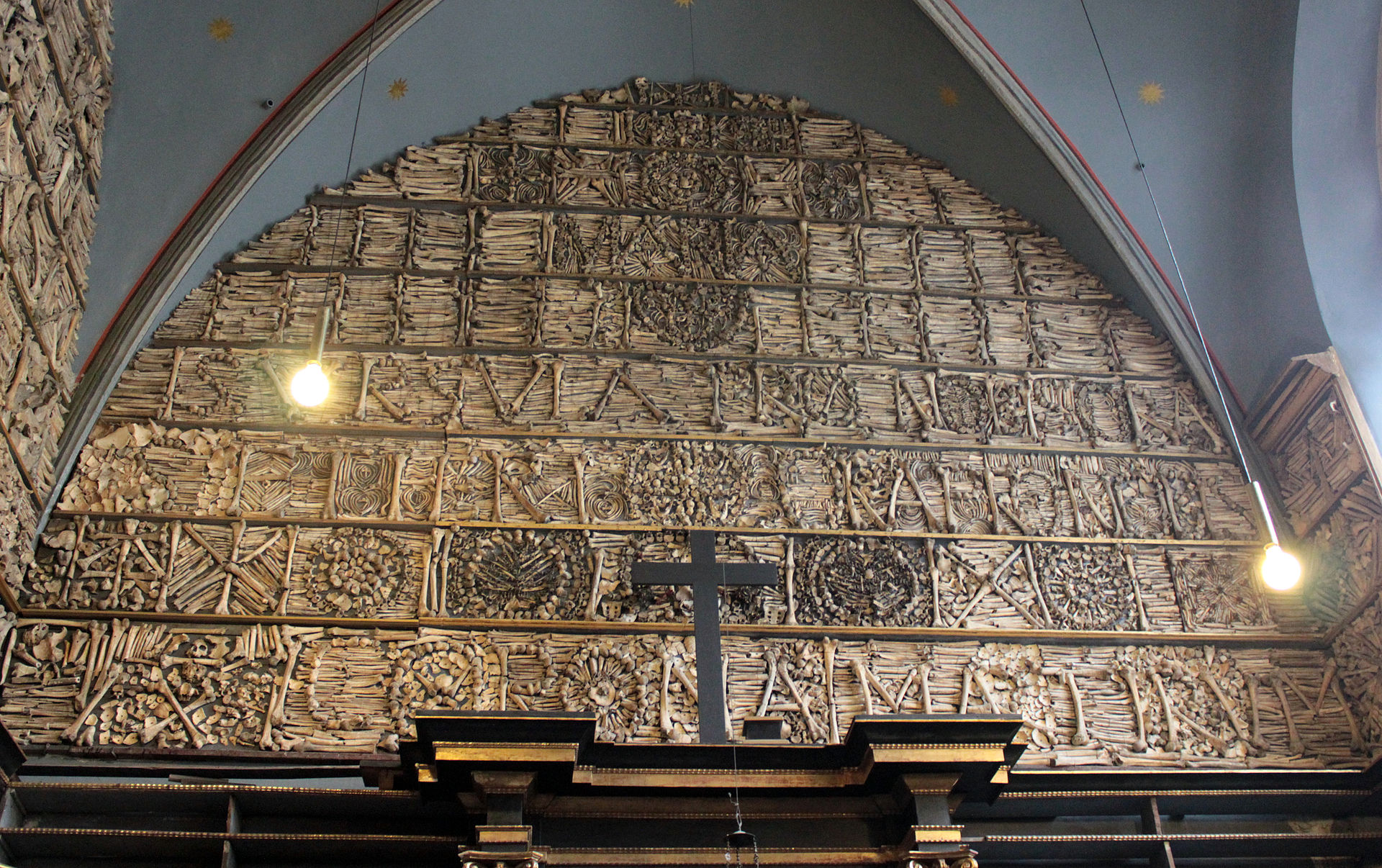
Interestingly, to shed more light on this story we can look to the 19th century German mystic, Blessed Anne Catherine Emmerich.
Emmerich received many visions of the Life of Christ, including his Passion (which famously became resource material for Mel Gibson's movie, Passion of the Christ) and the lives of a great number of saints—all in astonishing detail. One of these saints was St. Ursula.
Although her visions have not been approved by the Church, Emmerich's account well explains how a 4th century princess could be massacred along with 11,000 others. The story indicates that not all of the 11,000 were among her original group of handmaids (which was very large); rather, St. Ursula was an inspired leader of a large and virtuous group of people who followed her to win the crown of martyrdom.
When the Huns invaded the collapsing Roman Empire, pillaging and raping and spreading the terror of their barbarous ways, St. Ursula started what could be described as the world's first women's movement in history.
As you will read in Emmerich's account below, St. Raphael the Archangel appeared to St. Ursula and revealed to her that God, rather than permit the pagan Huns to violate a great number of women left defenseless from the marauding wars then sweeping across Europe, desired instead to save many for Himself as virginal martyrs. And St. Ursula was to be their fearless leader.
St. Raphael became St. Ursula's guide, instructing her in all that she should do to prepare a large group of women for a holy death as warrior-brides of Jesus Christ. This preparation included practicing the art of war, both physically and spiritually.
Those who fell before the Huns included, along with St. Ursula and her band of ladies, a large number of faithful who followed her movement, putting the number up to 11,000 who were killed in stages by the Huns in a rampage that lasted until the last of them was hunted down and killed.
Read the fascinating story according to the vision of Blessed Anne Catherine Emmerich below.
The Life of St. Ursula from the
The Life and Revelations of St. Anne Catherine Emmerich
"Ursula and her companions were massacred by the Huns, about the year 450, near Cologne and in other places. Ursula was raised up by God to preserve the maidens and widows of her time from seduction and dishonor, and to enroll them in the celestial army of crowned martyrs. She accomplished her mission with extraordinary energy and constancy.
The archangel Raphael was given her as a guide. He announced to her her task, saying that the mercy of God willed not that, at this frightful epoch of destruction, so many virgins and widows left defenseless and deprived of protectors by the bloody wars should fall a prey to the savage Huns ; rather should they die as innocent children than live to fall into sin.
Ursula was not exactly beautiful; she was tall and strong, resolute and energetic, of a very grave countenance and masculine bearing. She was, at the time of her martyrdom, thirty-three years old. I saw her as a little girl in the house of her parents, Deonotus and Geruma, in a city of England. The house stood on a broad street; it had steps before the door, and a metal railing with yellow knobs. It looked like the paternal house of St. Benedict, in Italy, which too had brass railings surmounting a low wall.
Ursula had ten playmates who joined her every morning and evening in an enclosed field where, divided into two bands, they exercised in running, wrestling, and even in the use of the lance.
They were not all Christians, though Ursula and her parents were. Ursula was the instructress of her companions, and she exercised them thus by order of her angel. Her parents often watched their games well-pleased. Maximian, a pagan, was then lord over England, and I am not now sure that he was not the husband of Ursula's eldest sister, Ottilia. Ursula had vowed herself to God.
A warrior, powerful and renowned, requested of her father the privilege of witnessing the exercises of the maidens of whom he had heard so much. Though embarrassed by the request, Ursula's father dared not refuse. He tried, at first, to put him off; but the man insisted until he gained his point. He was charmed with Ursula's skill and beauty and at once, asked her in marriage, saying that her young companions should espouse his officers in a country beyond the sea not yet peopled. I thought of Bonaparte, who made matches for his officers. I saw the father's deep affliction and the daughter's fright when apprised of this offer which could not be declined.
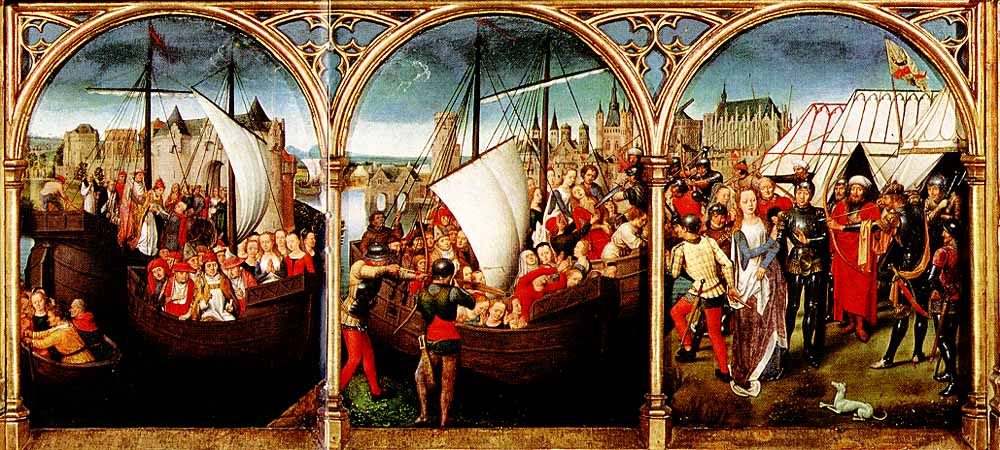
Ursula went by night to the playground and besought God in earnest prayer. The archangel Raphael appeared to her, consoled her, and instructed her to request that each of her companions might be allowed to choose ten other maidens, and to demand a delay of three years in which to practice all sorts of naval combats and maneuvers. He exhorted her to confidence in God, who would not permit her vow of virginity to be violated.
In these three years she was, with God's help, to convert her companions to Christianity. Ursula delivered these conditions to her father who, in turn, proposed them to the suitor. He accepted them. Ursula and her ten companions chose respectively ten other maidens, who became their pupils. The father had five small vessels fitted out for them, upon each of which were about twenty girls and also a few sailors to teach them how to manage the sails and fight at sea.
And now I saw them exercising daily, first in a river, then along the sea-shore. They sailed along quietly, gave one another chase, separated, leaped from ship to ship, etc. I often saw a crowd on the shore watching them, especially the father and suitor, the latter rejoicing in the prospect of soon having so valorous and skillful a wife; for he thought with such a one by his side, he would be able overcome every obstacle.
After awhile I saw the maidens practicing alone without the sailors, Bertrand, the confessor, and two other ecclesiastics being upon the vessels. Ursula had, by this time, converted all her maidens, among whom were some only twelve years old. They were baptized by the priests. Ursula's courage and confidence in God increased every day. I saw them landing on small islands and practicing their naval exercises, all accompanied with prayer and the chanting of the psalms, all performed with great freedom and boldness. Ursula's wonderful earnestness and courage are quite indescribable.
The maidens wore short dresses, descending a little below the knee; they were quite plain on the hips and had close-fitting bodies. Their feet were laced. Some had their hair uncovered and braided around the head, whilst others wore a sort of headdress with ends hanging behind. In their exercises they used light, blunt spears.
When the three years agreed upon drew to a close, I saw that the maidens were one heart and one soul.
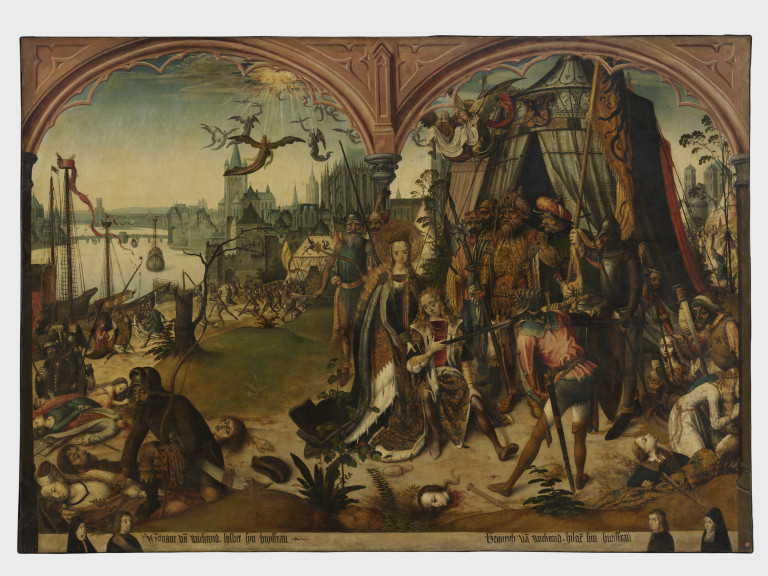
When, having already taken leave of their parents, they were about to embark to go to their future husbands, I saw Ursula in prayer. A luminous figure stood before her bidding her trust all to God, the Lord, who would give them the martyr's crown as His own brides, pure virgins; that she herself should propagate Christianity wherever the Lord would lead her; and that many virgins should through her be saved from dishonor and enter heaven adorned with the crown of martyrdom.
The angel ordered her also to proceed to Rome with part of her virgins. Ursula confided all this to her ten assistants whom it greatly encouraged. But as many of the others murmured against her because, having started for their nuptials as they thought, she now wanted them to be brides of Christ, Ursula went from ship to ship, reminding them of Abraham, of the sacrifice of his son, and of the miraculous help he had received from God. She told them that they, too, should receive similar strength to offer Him a pure and perfect sacrifice.
Then she ordered the cowardly to leave the vessels and return home; but all were encouraged by her words to remain faithful.
As they sailed from England under pretense of joining their destined husbands, a great storm arose which separated their vessels from those of their attendants, and drove them toward the Netherlands. They could make use of neither sails nor oars, and the sea miraculously arose as they neared the land. As soon as they disembarked, their dangers began. A savage nation tried to oppose their progress; but at Ursula's words, the maidens were allowed to return unmolested to their ships. A city lay at the point at which they quitted the open sea to sail up the Rhine, and here they encountered great troubles; but Ursula spoke for all, answered all.
When violent hands were about to be laid on the virgins, they boldly flew to arms and received supernatural assistance which paralyzed their aggressors, rendered them powerless to harm them.
Many maidens, as also widows and their children joined them on their journey. Before reaching Cologne, they were more than once challenged, interrogated, and threatened by the barbarous tribes along the shores. It was Ursula who always responded, and who urged her companions to ply their oars.
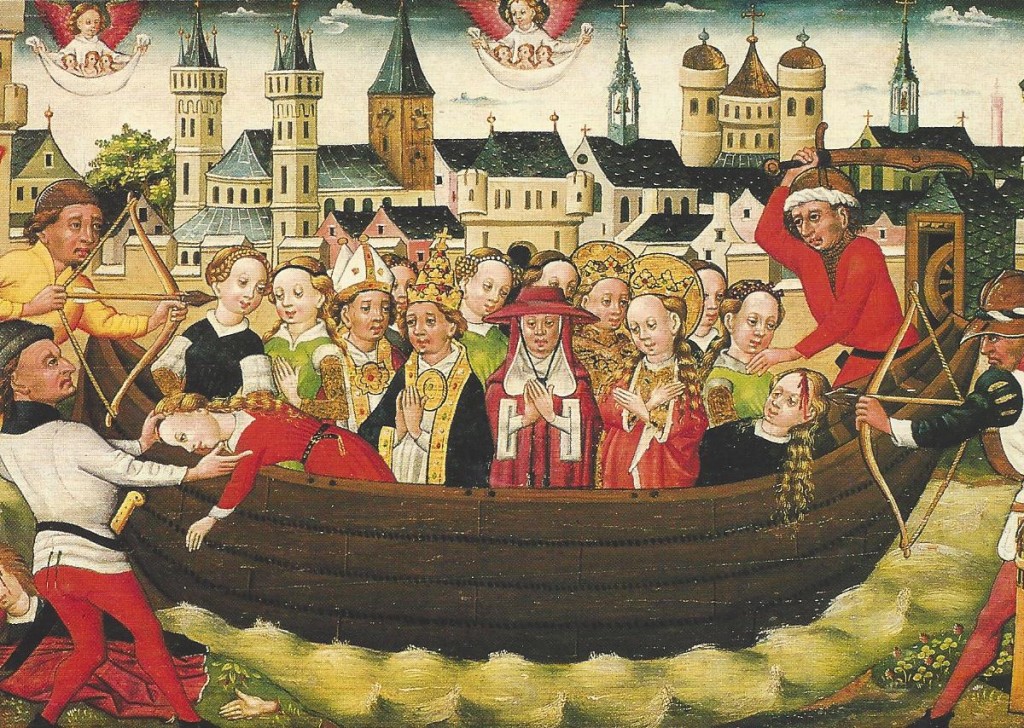
They arrived safe at Cologne where they found a Christian community and a little church. Here they sojourned for a time. The widows who had joined them on the journey and many young girls remained behind when Ursula proceeded further on her way.
Before setting out, however, she earnestly exhorted them to martyrdom as Christian matrons and virgins, rather than suffer violence from the pagan barbarians. They scattered throughout the surrounding district, spreading everywhere the teachings and heroic spirit of Ursula, who had departed with five vessels.
On reaching Basle, some of her little company remained therewith the ships whilst she herself set out for Rome with about forty of her maidens, accompanied by the priests and guides. They went processionally like pilgrims, through wildernesses and mountainous districts, praying and chanting psalms.
Wherever they halted, Ursula spoke of the espousals with Jesus and of the pure, immaculate death of virgins. Everywhere were they joined by recruits, whilst some of their number remained behind to diffuse their own spirit among the people.
At Rome they visited the tombs of the martyrs and the different places sanctified by their death. As they were informed that their short dresses and freedom of demeanor attracted attention, they procured mantles. The Pope, Leo the Great, sent for Ursula who disclosed to him the secret of her mission, related her visions, and received his advice with humility and submission. He gave her his benediction and presented her with some relics. On their departure, they were joined by Bishop Cyriacus and two priests, one Peter of Egypt, and the other from St. Augustine's birth-place, a nephew of the one who had bestowed lands on the saint for his monastery.
Reverence for the holy relics was their chief motive in following Ursula. She took with her to Cologne a relic of St. Peter which is still venerated as such, though none know whence it came; one of St. Paul; some hair of St. John the Evangelist, and a scrap of the garment he wore when cast into the boiling oil. On the return of the pilgrims to Basle, they were joined by so many recruits that eleven vessels were necessary to convey them to Cologne.
Meantime, the Huns had made an irruption into the country, bringing with them misery and confusion.
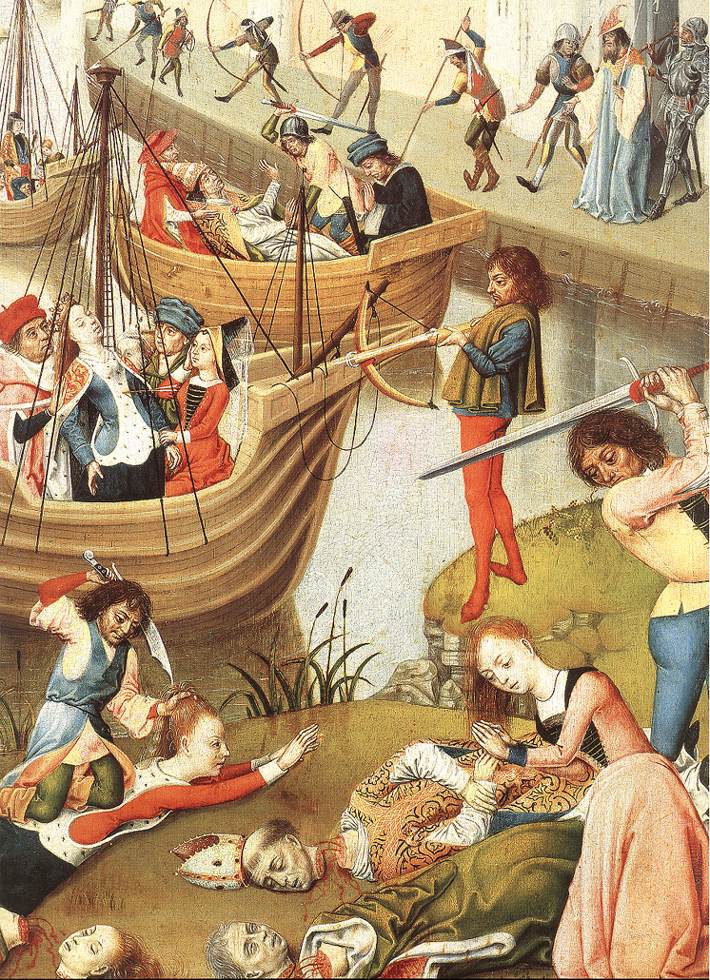
At some distance from the city, the angel Raphael appeared to Ursula in a vision, made known the approach of her martyr's crown, and told her all that she was to do; among other things, that she was to oppose resistance until her little army had been duly prepared and baptized. This vision Ursula communicated to her assistants, and all turned their thoughts to God.
As they approached Cologne, they were saluted by the shouts and darts of the Huns; but they rowed vigorously and passed the city. They would not have disembarked at all in its vicinity, were it not that so many of their party were there awaiting their arrival. They landed, therefore, about a league and a half above Cologne and halted in a field between two thickets where they pitched a sort of camp. Here I saw those that had remained behind hurrying to join them with their recruits. Ursula and the priests addressed the different bands and prepared them for the struggle.
The Huns approached and their leaders accosted Ursula; they insisted on being allowed to choose among the maidens. The latter, however, courageously prepared to defend themselves, whilst some of the inhabitants of the city and the country around who had suffered from the Huns, and others who had become acquainted with the virgins that had remained in Cologne, joined the pious little army armed with poles, clubs, and whatever else they could find. This was what had been commanded Ursula by the angel, that time might be gained until all were prepared for martyrdom.
During the engagement, I saw Ursula running hither and thither, zealously exhorting the bands in the rear and ardently praying. The priests were everywhere busily baptizing, for numbers of pagan women and girls had come over to them. By the time all were prepared for death, the Huns had surrounded them on all sides. They now ceased defending themselves and gave themselves up to martyrdom, singing the praises of God.
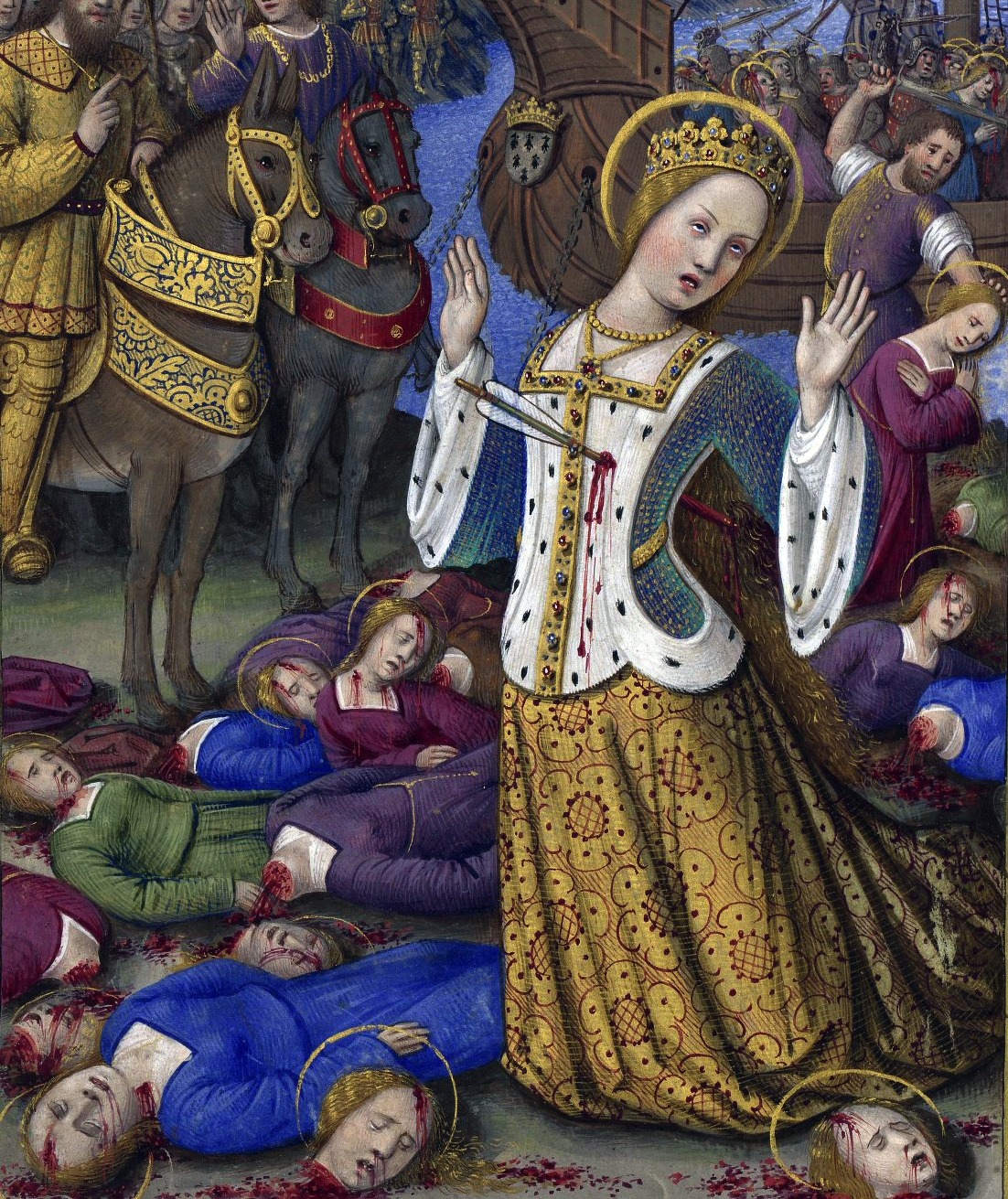
Then the Huns fell upon them and slew them with axe and spear. I saw a whole row of virgins fall at one time under the darts of the barbarians; among them was one named Editha, of whom we have a relic. Ursula herself fell pierced by a lance. Among the bodies that strewed the field of martyrdom there were, besides the British virgin great numbers of those that had joined them at various places, also the priests from Rome, some other men, and some of their enemies. Many more were massacred on board the ships.
Cordula was not among those who had accompanied Ursula to Rome. She remained at Cologne where many joined her. When the slaughter began, she hid at first through fear; but she afterward gave herself up with all her companions, requesting to be put to death. The Huns were eager to spare them; but they offered so sturdy a resistance that, after a long delay, they were placed in a line, bound together by the arms, and shot with arrows. They went joyfully singing and dancing to martyrdom as if to a marriage-feast.
Later on many others gave themselves up and were put to death in different parts of the country. Shortly after, the Huns withdrew from the district. The bodies of the virgins and other martyrs were soon after interred in an enclosed field near Cologne. Deep pits were dug and walled in, and there the bodies were devoutly laid in rows.The ships of the virgins were open, beautiful, and very light, with galleries around them from which floated little standards; they had masts and projecting sides. By the oars ran benches used both for seats and births. I have never seen vessels so well ordered.
About the time that Ursula left England, the saintly Bishops, Germain and Lupus, lived in France; the former visited St. Genevieve, in Paris. She was then about twelve years old. When he crossed over to England with Lupus to combat the heretics, he consoled the parents of Ursula and those of the other maidens. The Huns mostly went bare-legged; they had leathern thongs hanging around the lower part of their body, and wore wide jackets and long mantles. These last they often rolled up and carried on their shoulders."
Excerpt taken from The Life and Revelations of Anne Catherine Emmerich
